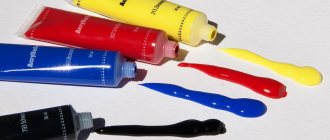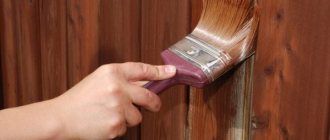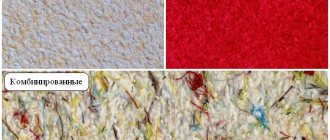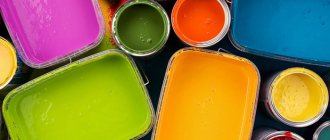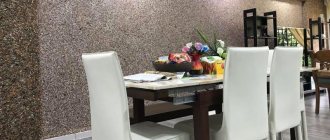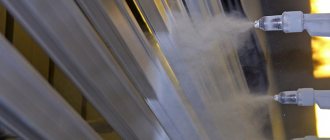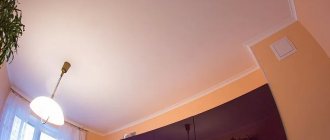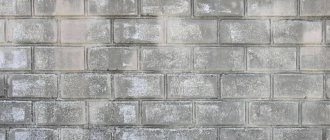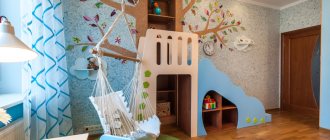Liquid wallpaper is a popular finishing material that allows you to paint walls or ceilings without special skills. With its help, you can create a unique room design, since the material allows you to change the texture of the surface or apply unique patterns. The article will help you figure out whether it is possible to paint liquid wallpaper and how to do it correctly yourself.
Why do you need painting?
Before purchasing, many consumers ask themselves the question: is it possible to paint any liquid wallpaper? And not without reason, because any interior sooner or later can lose its attractiveness and novelty. In order not to redo the repair again, the surface can be updated.
There are several reasons for painting:
- Additionally protect the coating;
- Increase service life;
- Change or refresh color;
- Remove blemishes or stubborn stains.
There are several variations of the material: silk, cotton and cellulose. The latter are ideal for walls with flaws, allowing you to hide any unevenness.
In order not to redo the repair again, the surface can be updated.
Painting
Painting is not a difficult job, but it is better to pay attention to your tools.
You will get the most even color with a spray gun or sprayer. Painting will be easy, and the paint will lay down in a smooth layer without streaks. If you want to get small geometric stains, then it is interesting to use a roller and apply two layers of paint. First, make the first layer for the background as even as possible, and the second, using a roller randomly and without pressing slightly on the wall. The result is a beautiful effect that will look great on bright and dark colors. Using a brush with hard bristles you can get an additional light texture on the wallpaper.
Use what is convenient for you, then painting liquid wallpaper will be easy and serene.
Advice: paint for liquid wallpaper is a concept that does not exist in construction slang, since there is simply no specialized paint for it. When choosing materials, keep in mind the humidity of the room you want to paint.
Think about whether you need to paint liquid wallpaper or whether it’s better not to save money and do the renovation again. Every decision is not possible without its pros and cons, so, of course, proceed from your own benefit and the comfort of the room. Good luck!
Advantages and disadvantages
Before updating liquid wallpaper on the walls, you need to evaluate all the nuances of painting. The main advantages include the following features:
- Changing the design of the room;
- Large selection of color palettes;
- Correction of surface defects;
- Easy to paint;
- Reusable coloring available.
However, users also highlight a number of disadvantages:
- Painted wallpaper cannot be reused;
- The coating loses good breathability;
- The original surface structure is damaged.
Wide choice of color palette.
Pros and cons of painting
Applying paint over wallpaper allows you to:
- update the interior quickly and at minimal cost;
- eliminate visible base defects;
- restore the interior design without removing the old coating;
- preserve the originality and texture of the main coating;
- create a layer that is not afraid of regular washing, including using household chemicals.
See also
Types of infrared lamps for drying cars, rating and review of the best brands
Painting wallpaper is attractive because this procedure can be carried out repeatedly, without removing each time the already applied layer of finishing material.
Among the disadvantages of this method of interior restoration are the following:
- unique patterns are lost, since the paint hides the small details of the liquid wallpaper;
- tactile sensations change when touching the surface, as the material becomes harder and colder after painting;
- vapor permeability decreases.
When painting wallpaper, it is important to follow both the application technology and the manufacturers' recommendations. Otherwise, the treated base will begin to peel off. After painting the surface, it becomes impossible to carry out local repairs and eliminate minor defects without removing the liquid wallpaper. In addition, if there are grease stains on the wall, the procedure cannot be carried out.
Types of paints for liquid wallpaper
One way to update wallpaper is to remove it from the surface, soak it, tint it and apply it again. In the second case, liquid wallpaper paint is used, which is applied directly to the wallpaper. The choice depends on the budget and the desired effect, since each type of dye has its own nuances. Let's take a closer look at how to paint liquid wallpaper on a wall.
The choice depends on the budget and the desired effect.
Water-based paint
Painting with this type of dye has a number of advantages: ease of application, quick drying, practicality and low price. The water-based emulsion is sold ready-made and applied directly to the surface. The base is always white; it must first be mixed with the desired color. If the paint has thickened slightly, before painting the liquid wallpaper with water-based paint, you need to dilute it a little, gradually adding water.
The water-based emulsion is sold ready-made and applied directly to the surface.
Acrylic paints
These are resistant to temperature changes and have good protective functions due to the formation of a durable elastic film. It applies well and dries fairly quickly (up to two hours). Despite the fact that acrylic is somewhat more expensive than water-based paint, the difference in price is justified - the acrylic coating will last longer and more reliably protect the surface from damage.
They are resistant to temperature changes and have good protective functions.
Latex paint
Latex paint is a water-dispersion mixture where the binder is latex. This coating has a number of advantages:
- Quick drying;
- No smell;
- Good adhesion;
- Environmental friendliness;
- Easy to care for.
If exposed to too low a temperature, the latex coating may crack and pull away from the walls. In rooms with high humidity, the growth of bacteria, fungus and mold cannot be ruled out.
Latex paint is a water-dispersion mixture where the binder is latex.
Silicone paint
Silicone coating is the most expensive of all listed, but also the most practical. Its advantages include:
- High moisture resistance;
- Good breathability;
- Environmental friendliness;
- Resistance to damage;
- Resistance to temperature changes;
- Good protective and camouflage ability;
- Lack of sensitivity to high humidity.
Varnish compositions are often used for painting. It is recommended to choose a water-based varnish, as it does not change the structure of the material and is easier to apply.
Silicone coating is the most expensive of all listed, but also the most practical.
Features of the material
The material is a dry powder packed in a bag. Before use, it is diluted with warm, clean water. Some people think that the purity of water is not so important, but this is not true: this delicate material loves neatness.
What is this material
The technology for applying the material is almost similar to the technology by which decorative plaster is applied to walls. The result is a perfectly flat, seamless surface. There are no seams or joints.
Note! The unofficial name for wallpaper is “perpetual material.”
The manufacturer claims that its service life is 10 years. But in practice, the coating lasts much longer.
The main advantages are aesthetics and cost-effectiveness. Price per 1 sq. m. varies from 300 to 1200 rubles. But, given the high quality of the product, as well as its unique properties, it is worth it.
The coating is easy to clean and repair. It not only perfectly hides cracks and other wall defects, but also straightens slight curvature of the walls.
Materials and tools
Before painting liquid wallpaper, it is recommended to stock up on the necessary tools and available materials. In addition to the paint itself, the master will definitely need:
- Roller with fur base;
- Extension for roller handle;
- Container for dye;
- Paint brush;
- Masking tape;
- Spray;
- Putty and primer;
- Film or paper.
For painting, it is recommended to use a spray bottle, since it is more convenient and faster to apply paint, although the consumption of material may increase.
Before painting liquid wallpaper, it is recommended to stock up on the necessary tools and available materials.
Composition of liquid wallpaper and delivery options
For decoration, beads, mother-of-pearl, and silk fibers are added to liquid wallpaper.
Liquid wallpaper contains natural components in the form of fibers, which create a surface that is pleasant to the touch and resembles decorative plaster in appearance.
Also, thanks to the materials that make up them, they are safe for health, multifunctional and fit quite harmoniously into any modern interior.
The components included in liquid wallpaper can be the following:
- fibers from silk, cellulose or from an artificial base: wool yarn, silk, cotton, acrylic, CMC glue;
- decorative elements: beads, mother-of-pearl, mica, glitter;
- mineral fillers;
- colored quartz;
- antiseptics and adhesives;
- multi-colored granules, stone chips, colored threads.
Mixtures for preparing liquid wallpaper are prepared in the factory. Liquid wallpaper can be sold in the following forms:
- the materials included in the liquid wallpaper are pre-mixed, and after adding water and thoroughly mixing the resulting mixture, the composition for applying liquid wallpaper is ready;
- materials are provided in separate containers that must be mixed strictly following the instructions.
Also, at the request of the owner of the premises being repaired, additional materials from those listed earlier can be added to the composition of ready-made mixtures or mixtures mixed from components prepared at a specialized enterprise.
Liquid wallpaper can be diluted independently.
Preparing the walls
Before starting work, you should clear the room of foreign objects, remove sockets and switches, and cover the floor, doors and windows with film. To prepare the walls you should:
- Remove dirt and stains from the surface with alcohol or solvent.
- Stains that cannot be removed should be removed with a spatula along with the wallpaper.
- Use putty to repair all flaws and damage. There is no need to level out the corrected areas in order to disturb the texture of the wallpaper.
- For better adhesion of the paint, apply a primer to the surface after drying.
If there is fungus, it is first recommended to remove it and treat the surface with an antiseptic.
For better adhesion of the paint, apply a primer to the surface after drying.
Mixture consumption
Before starting to mix the composition and themes, it is necessary to determine as accurately as possible the consumption of material per unit area so that the prepared mixture is enough to cover the entire surface planned for wallpapering and there is no excess volume left that will be thrown away.
Per 1 m2 is indicated on the packaging of the material, but this is a relatively dry composition; when the components are dissolved in water, this value will be greater. In practice, this indicator will correspond to the data given in the table:
In addition, this indicator may depend on the degree:
- if the walls are perfectly smooth, the mixture consumption will be minimal;
- if there are sinkholes, potholes, cracks and other defects on the walls, then the consumption of liquid wallpaper will increase in proportion to the number and volume of existing coating defects.
When purchasing the composition in a store, you can purchase the material with a reserve, having previously agreed on the possibility of returning the remaining goods.
Liquid wallpaper should not be used to level walls or fill any defects on them.
Liquid wallpaper is not suitable for leveling walls.
For these purposes, it is necessary to use plaster and putty compounds specially designed for this purpose.
If after work there is still unused liquid wallpaper in the form of a mixture and in the future it is necessary to carry out work on applying it to other surfaces, then it can be stored in a closed container for several weeks.
Preparation of the working mixture for applying liquid wallpaper to walls must be done in advance, since the finished mixture can be stored in a hermetically sealed container and even in a plastic bag for several weeks.
To make it convenient to work with the prepared composition, it must be kept for 8-12 hours. During this period of time, the mixture will acquire a consistency at which the liquid wallpaper can be evenly distributed over the surface.
Use warm water for kneading
Liquid wallpaper, instructions for which are included with purchase, must be purchased in specialized stores to avoid low-quality material.
Mixing the components of liquid wallpaper with water must be done in strict accordance with the instructions and compliance with the following requirements:
After preparing a test portion of the mixture, it is necessary to apply liquid wallpaper according to the application instructions on the surface to be treated and leave for some time to allow it to dry. For more information about kneading, watch this video:
You cannot pour water into a dry mixture; on the contrary, you can gradually add dry ingredients to the water, stirring the solution evenly.
When adjusting the composition, you can experiment by increasing or decreasing the content of certain components in the mixture.
Liquid wallpaper painting technology
The technology for applying paint is quite simple and does not require special skills from the master. The following describes how to paint liquid wallpaper using a roller:
- Stir the paint in the same container in which it was packaged.
- Fill the pre-prepared container with dye.
- Dip the roller into the paint, removing excess on the sides of the container.
- Apply the coloring composition to the surface, making horizontal and vertical movements alternately.
- Repeat the procedure several times, applying two or three layers of paint only after the previous one has completely dried.
- Apply paint at the joints using a narrow brush.
When using a spray gun, pre-regulate the compressor pressure to avoid changes during operation. The tank is filled with paint and the wallpaper is painted, holding the sprayer at a distance of 12-25 cm from the surface.
For better adhesion of the paint, apply a primer to the surface after drying.
How to apply color
You can change the color of liquid wallpaper with your own hands at home immediately before application. In specialized stores that provide customers with computer paint tinting services, this will not be possible for the following reasons:
- It is impossible to tint a dry mixture , which is what liquid wallpaper is, which is mixed with water before application.
- The finished colored mass must be used immediately, within 2–2.5 hours from the moment of tinting. If you miss time, the color may “mutate”.
The color mass must be used within a maximum of 3 hours, otherwise it will change shade
But don’t be afraid to work with color – it’s not difficult, and even interesting. To ensure everything works out as planned, listen to the following tips and recommendations:
- Study the shade chart on the dye package.
- Select the tone you need and see in what proportions the pigment is mixed with the base.
Tint card
- Dissolve the wallpaper color in water to mix liquid wallpaper.
- Pour in the dry mixture, mix gently and wait for the required time.
It is better to mix the mixture by hand
- You can add mineral additives, glitter, and other decorative filler to the solution.
Sequins for decoration
- Apply a small amount of liquid wallpaper onto a sheet of paper or directly onto the wall in the room you will be decorating and evaluate the color. If necessary, add a little more pigment and water to the solution and mix thoroughly.
The photo shows a comparison of different shades
- Keep in mind that the mixture looks brighter in solution than on the wall after drying.
The most difficult thing in this matter is to achieve the same shade for all batches. Therefore, you need to either knead the entire volume at once, or accurately count and remember the proportions.
But in any case, try to prepare such an amount of mixture that it is enough for one wall. When moving to another plane, the difference in shades is not as noticeable as on one straight section.
If you don’t like the color of the sample on the wall, it can be easily removed by soaking the composition with water and removing it with a spatula.
Caring for liquid wallpaper
If liquid wallpaper is covered with a layer of varnish, wet treatment is allowed to remove dirt. In all other cases, clean the surface with a vacuum cleaner using a brush attachment. If there are stains on the surface, the damaged area is restored:
- The area where the stain has formed is moistened with warm water.
- Contamination is removed with a knife or spatula.
- A new layer of wallpaper is applied to the cleaned area.
The restored area may differ in color from the rest of the surface. After some time the shade will even out.
If liquid wallpaper is covered with a layer of varnish, wet treatment is allowed to remove dirt.
Before you paint liquid wallpaper, you should remember that you won’t be able to use it again. But you can repaint it an unlimited number of times, changing the design of the room without significant investment.
How to remove liquid wallpaper from a wall
How to remove liquid wallpaper from a damaged wall?
- For this, a sprayer is useful; use it to spray water onto the damaged area and wait for the moisture to be absorbed; the material will become soaked and you can proceed to removal using a spatula or plastic grater.
- The varnished layer can be removed using the same method, but it will take longer to wait until the water penetrates the structure of the canvas.
- With complete removal, it is permissible to dilute the water with detergents, but in the future the material will lose its properties and will not be suitable. The process of complete removal will take some time and effort, the work itself can be considered not labor-intensive, and if you soak the base well, there will be no difficulties.
- Use a steam generator by directing a stream of steam at the wallpaper. Speed up your work. Even simple warm water applied with a brush or rag quickly penetrates the layers, and the surface can be removed.
Also read: How to properly care for laminate flooring and repair chips
Updating worn-out areas.
- You need to remove liquid wallpaper without sharp cutting, then it is advisable to retouch the edges.
- We prepare the surface by completely removing the remains of old fragments. You can lightly sand and saturate the bare area with primer.
- After all the preparatory work, we proceed to applying the material using conventional technology, adding the required amount to the area and rubbing it in with a trowel, creating a single layer. This is how liquid wallpaper is replaced.
- Observe the thickness of the applied fragment so that the thickness corresponds to the previous coating, and when filling the niche there is no bulge.
- A new solution is applied to the local area, or perhaps there is a residue from a previous repair. You purchase a new batch according to the colors and markings.
It is also permissible to use a damaged piece of wallpaper if it is not heavily soiled and retains the same color scheme. They do not need to be removed from the wall, just soak the surface and evenly smear the damaged part.
White liquid wallpaper: universal interior options
When choosing the color scheme of liquid wallpaper, you should not forget about such a universal neutral color as white.
White silk cotton plaster is ideal for wall decor because white color:
- Serves as an excellent background;
- Combines with any other color;
- Pairs well with black, red and brown elements;
- Dark polished wood furniture looks beautiful against a white background.
The versatility of white in wall and ceiling decoration comes to the rescue if the room is dark, north-facing or narrow. The combination of white and yellow is great for children. But the duet of white with dark or bright green creates a fresh and life-affirming atmosphere.
An interior with a predominance of white is a promising color solution for the entire house or apartment.
